
PATRIOTIC BRANDING: WHEN A FLAG IS NOT A FLAG
As we celebrate the anniversary of our nation’s founding, it’s time to examine when national insignias can be registered with the U.S. Trademark Office. Under Section 2 of the Trademark Act (15 U.S.C. §1052), Congress set forth its ‘five deadly sins’, also known as the ‘absolute bars to registration’. Among this ignoble quintet is subsection (b), in pertinent part:
No trademark by which the goods of the applicant may be distinguished from the goods of others shall be refused registration on the principal register on account of its nature unless it—
(b) Consists of or comprises the flag or coat of arms or other insignia of the United States, or of any State or municipality, or of any foreign nation, or any simulation thereof.
So what does this mean for companies interested in capitalizing on our national heritage? If intending to perfect their rights through a federal trademark registration, they need to tread very carefully, to paraphrase the Gadsden flag of the American Revolution.
Turning now to Section 1204 of the Trademark Manual of Examining Procedure (TMEP) for further guidance, whether such national symbols are denied registration is essentially based on the following language and supporting case law:
The incorporation in a mark of individual or distorted features that are merely suggestive of flags, coats of arms, or other insignia does not bar registration under §2(b).
Finally, the TMEP provides several helpful examples of the same. First, are those where trademark registration has been denied for reasons of verisimilitude, irrespective of color claim:




Next are illustrative examples of such insignia that were approved for trademark registration by the USPTO. According to Section 1204.01(b) of the TMEP, registration may be granted if incomplete or stylized elements of flags are contained within the mark as follows:
If the flag design fits one of the following scenarios, the examining attorney should not refuse registration under §2(b):
- The flag design is used to form a letter, number, or design.
- The flag is substantially obscured by words or designs.
- The design is not in a shape normally seen in flags.
- The flag design appears in a color different from that normally used in the national flag.
- A significant feature is missing or changed.





Of course, there’s one major caveat to the above. While flags of former countries are to be accepted by the USPTO, with apologies to one Ms. Ross, former flags of currently existing nations, such as the original U.S. flag of the thirteen colonies, will be denied registration.
Although some of this may seem a bit counterintuitive at first, once familiar with the basic concepts and carve-outs, business owners and brand managers alike should be able to successfully navigate this unfamiliar terrain, just like General George at Valley Forge back in 1778. Happy Birthday, America!